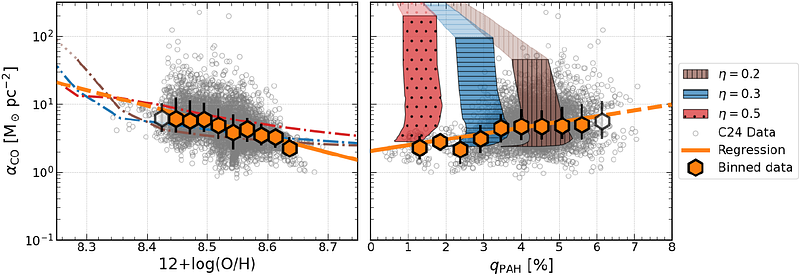CO-to-H$_2$ conversion factor and grain size distribution through the analysis of $α_\mathrm{CO}$-$q_\mathrm{PAH}$ relation

CO-to-H$_2$ conversion factor and grain size distribution through the analysis of $α_\mathrm{CO}$-$q_\mathrm{PAH}$ relation
I-Da Chiang, Hiroyuki Hirashita, Jeremy Chastenet, Karin M. Sandstrom, Eric W. Koch, Adam K. Leroy, Yu-Hsuan Teng, Thomas G. Williams
AbstractThe CO-to-H$_2$ conversion factor ($\alpha_\mathrm{CO}$) is expected to vary with dust abundance and grain size distribution through the efficiency of shielding gas from CO-dissociation radiation. We present a comprehensive analysis of $\alpha_\mathrm{CO}$ and grain size distribution for nearby galaxies, using the PAH fraction ($q_\mathrm{PAH}$) as an observable proxy of grain size distribution. We adopt the resolved observations at 2-kpc resolution in 42 nearby galaxies, where $\alpha_\mathrm{CO}$ is derived from measured metallicity and surface densities of dust and HI assuming a fixed dust-to-metals ratio. We use an analytical model for the evolution of H$_2$ and CO, in which the evolution of grain size distribution is controlled by the dense gas fraction ($\eta$). We find that the observed level of $q_\mathrm{PAH}$ is consistent with the diffuse-gas-dominated model ($\eta=0.2$) where dust shattering is more efficient. Meanwhile, the slight decreasing trend of observed $q_\mathrm{PAH}$ with metallicity is more consistent with high-$\eta$ predictions, likely due to the more efficient loss of PAHs by coagulation. We discuss how grain size distribution (indicated by $q_\mathrm{PAH}$) and metallicity impact $\alpha_\mathrm{CO}$; we however did not obtain conclusive evidence that the grain size distribution affects $\alpha_\mathrm{CO}$. Observations and model predictions show similar anti-correlation between $\alpha_\mathrm{CO}$ and 12+log(O/H). Meanwhile, there is a considerable difference in how resolved $\alpha_\mathrm{CO}$ behaves with $q_\mathrm{PAH}$. The observed $\alpha_\mathrm{CO}$ has a positive correlation with $q_\mathrm{PAH}$, while the model-predicted $\alpha_\mathrm{CO}$ does not have a definite correlation with $q_\mathrm{PAH}$. This difference is likely due to the limitation of one-zone treatment in the model.